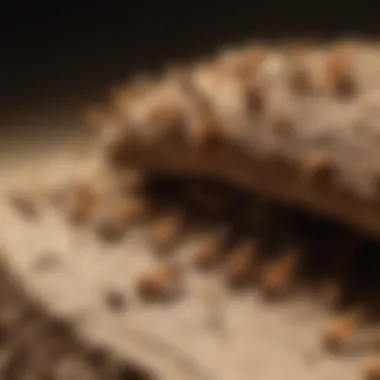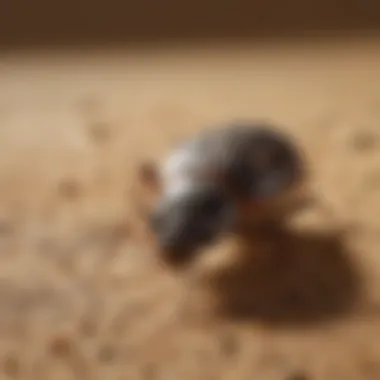Star Termite & Pest Control: Comprehensive Insights


Understanding Pests
Pests can be broadly defined as organisms that cause harm to human interests, whether through direct damage or by spreading disease. They can range from insects like termites and ants to rodents and even larger animals. Having a profound grasp of what constitutes a pest is essential for effective management and control. By understanding the different types of pests, homeowners can better prepare and react to infestations.
Importance of Pest Identification
Identifying pests is a pivotal step in controlling them. Proper identification helps determine the most effective treatment options. For example, termites and carpenter ants may cause similar damage, but they require different approaches for elimination. Without accurate identification, homeowners risk wasting time and resources on ineffective methods or, worse, exacerbating the infestation. Thus, learning to recognize key signs of infestation, such as droppings, nests, or damage to structures, is vital for effective pest management.
Prevention Techniques
Effective pest control begins long before pests are noticed. Prevention is key to maintaining a pest-free home environment.
Home and Garden Preventative Measures
In the pursuit of pest control, specific preventive measures should be considered:
- Sealing Entry Points: Cracks, gaps, and holes in windows, doors, and foundations should be routinely sealed. This limits access points for pests.
- Proper Waste Management: Maintaining a clean kitchen is essential. Ensure that food is stored in airtight containers and that trash is disposed of regularly.
- Landscape Maintenance: Keeping vegetation trimmed away from the house is essential. Overgrown plants can provide cover for pests, allowing them to invade.
Seasonal Prevention Tips
Different pests emerge during various seasons. Therefore, seasonal vigilance is important. In spring, for instance, ants and termites become more active. Regular inspections should be part of the seasonal routine, focusing on areas prone to moisture, as damp conditions attract many pests.
Eco-Friendly Pest Control Solutions
The rise in environmental consciousness has led to a shift towards eco-friendly pest control solutions. Homeowners are increasingly seeking ways to manage pests without harming the environment.
Overview of Sustainable Practices
Sustainable pest control practices aim to minimize chemical usage while maintaining efficacy. Integrated Pest Management (IPM) is a prominent technique proving effective. IPM emphasizes the use of biological controls, habitat manipulation, and monitoring to reduce pest populations to acceptable levels.
Natural Remedies and Their Effectiveness
Natural remedies exist as alternatives to chemical interventions, often boasting fewer side effects. Some common examples include:
- Diatomaceous Earth: This natural powder is effective against insects like ants and bedbugs. It works by damaging their exoskeletons.
- Essential Oils: Oils such as peppermint and tea tree can act as repellents against various pests.
- Soap Solutions: Mixing liquid soap with water can be effective against aphids and spider mites when sprayed directly onto them.
"Effective pest control is a balance between maintaining a healthy home and protecting the environment."
Understanding Pests
Understanding pests is crucial in shaping effective pest control strategies. This section focuses on defining what pests are, exploring common types of pests, and examining their ecological impacts. By grasping these elements, homeowners can make more informed decisions about pest control methods and their long-term implications.
Definition of Pests
Pests are organisms that are considered undesirable, often because they cause harm to humans, property, or the environment. This includes insects, rodents, and other creatures that invade homes or gardens, leading to structural damage or health risks. Understanding the definition of pests is essential as it sets the foundation for distinguishing beneficial insects from harmful ones. Recognizing which species fall into the pest category helps in targeting the right control measures, reducing unnecessary harm to non-pest species.
Common Types of Pests
Termites
Termites are significant pests, mainly known for their wood-eating habits. They may cause extensive damage to structures, which can lead to costly repairs. One key characteristic of termites is their colony-based social structure, which allows them to consume wood in large quantities. This communal feeding behavior can be seen as a disadvantage as it accelerates the potential for property destruction. For this article, understanding termites is important because it highlights how quickly an infestation can escalate and the importance of timely intervention.
Ants
Ants are among the most common household pests. Their colonies can range from a few dozen to thousands of individuals. A notable characteristic of ants is their foraging behavior, often leading them into homes in search of food. Ants serve as a beneficial choice in this article as their presence is generally less harmful than termites or rodents. However, the unique feature of ant infestations is their ability to establish numerous nests, making them difficult to eradicate once they invade. Thus, understanding their behavior is key when discussing prevention and treatment strategies.
Rodents
Rodents, such as mice and rats, can cause serious issues in households. They are notorious for chewing on electrical wires, leading to fire hazards. A key aspect of rodents is their rapid reproductive cycle, which can lead to a quickly escalating infestation. This makes them a significant focus of pest control efforts. The unique feature of rodents is their adaptability to various environments, allowing them to thrive even in urban settings. This adaptability poses challenges in prevention efforts, which makes understanding their habits vital.
Bed Bugs
Bed bugs present a unique challenge in pest control. They are small, nocturnal insects that feed on human blood. One key characteristic is their ability to hide in tiny crevices, making detection difficult. The impact of bed bugs on human health and comfort cannot be understated; their bites can cause allergic reactions and stress. In this article, bed bugs serve as a prime example of how certain pests require targeted treatment methods due to their unique behavior and the discomfort they cause to homeowners.
Ecological Impact of Pests
Understanding the ecological impact of pests involves looking at both their roles in ecosystems and the negative consequences of infestations.
Role of Insects in Ecosystems
Insects play vital roles in ecosystems, contributing to soil health, pollination, and food chains. They facilitate processes like decomposition, which enriches the soil and promotes plant growth. This aspect makes them an essential point in the article because understanding the beneficial roles insects serve helps in distinguishing harmful pests from beneficial insects. A key characteristic of this section is its focus on ecosystem dynamics, which emphasizes why balanced pest management is necessary.
Negative Effects of Infestations
Infestations can pose serious issues for homeowners. They can lead to structural damage, health risks, and even loss of property value. The presence of pests often requires professional intervention, leading to increased expenditures on pest control services. Understanding these negative effects is crucial as it frames the importance of proactive pest management strategies. Highlighting this aspect equips readers with knowledge essential for recognizing the urgency and impact of pest infestations on their properties.
The Lifecycle of Termites
Understanding the lifecycle of termites is crucial for effective pest management and prevention strategies. Knowledge about their developmental stages helps identify when and how to intervene. This section will describe the stages of termite development, as well as their behavioral patterns that are essential for both homeowners and pest control professionals. Recognizing these patterns can enhance monitoring efforts and lead to more efficient extermination techniques.
Stages of Development
Egg Stage
The egg stage of termites is the initial phase in their lifecycle. A single queen termite can lay thousands of eggs, which hatch in about two weeks. This rapid reproduction rate makes it essential to manage infested areas quickly. The eggs are small and white, making them hard to see, which adds to their dangerous nature. The importance of this stage lies in its sheer volume; a small infestation can grow quickly.
Key Characteristic: The eggs are protected by a gelatinous coating that helps keep moisture in, allowing them to thrive in various environments. This adaptation is beneficial for ensuring the survival of the next generation in suitable conditions.


Unique Feature: The eggs are often laid in clusters, providing better survival chances.
Nymph Stage
After hatching, young termites enter the nymph stage. This stage can last from a few weeks to several months, depending on environmental factors. Nymphs gradually mature and take on various roles within the colony. They start as workers and may transition to soldiers or reproductive termites as they grow.
Key Characteristic: Nymphs are similar to adults but smaller in size and do not yet have fully developed reproductive organs. This versatility makes them a significant asset to the colony.
Unique Feature: Their ability to change roles is essential for maintaining the colony's health and productivity. This adaptability allows the colony to respond to environmental pressures effectively.
Adult Stage
The adult stage marks the culmination of the termite lifecycle. Adults are fully developed and capable of reproduction. In a colony, there can be thousands of adults, including specific roles like the queen, king, workers, and soldiers. The queen can continue to lay eggs throughout her life, which can be many years.
Key Characteristic: Adults have a segmented body, with a distinct waist, making them distinguishable from other pests. Their long lifespan contributes significantly to the ongoing pest problem.
Unique Feature: The division of labor among the adult termites enables highly efficient operation within the colony. Each group has specialized duties, which enhances colony survival and prosperity.
Behavioral Patterns
Social Structure
Termites exhibit a complex social hierarchy. The colony consists mainly of workers, soldiers, and reproductive individuals, including a queen and king. Workers perform most of the tasks—such as building nests, foraging for food, and caring for nymphs—while soldiers defend the colony.
Key Characteristic: The cooperative behavior of termites facilitates their survival in various environments. This social system increases the likelihood of a colony reaching maturity and developing into a larger infestation.
Unique Feature: The interconnected roles ensure efficiency within the colony. However, this structure can also lead to rapid growth, making management more challenging for homeowners.
Feeding Habits
Termites primarily feed on cellulose, which is found in wood, plants, and other organic materials. Their diet presents a considerable threat to household structures, as they can silently consume wood from within. They require a constant source of cellulose, making infested structures particularly vulnerable.
Key Characteristic: Their ability to digest cellulose is facilitated by symbiotic microorganisms in their guts. This process enables them to extract energy from materials unsuitable for other pests, emphasizing their adaptability.
Unique Feature: Termites can open new feeding sites rapidly, which allows them to exploit different areas of a home or structure continuously. This adaptability to diverse feeding options can worsen infestations quickly.
Understanding these key aspects of termite development and behavior is only a piece of comprehensive pest control. Homeowners and pest control professionals must keep these details in mind when implementing effective strategies.
Star Termite & Pest Control: Overview
Understanding how Star Termite & Pest Control operates is essential for anyone looking to address pest challenges effectively. This section provides a thorough insight into the company's framework, its services, and why they stand out in the pest control industry. The company emphasizes a comprehensive approach that merges expertise with customer-centric strategies.
Company Profile
Star Termite & Pest Control has established itself as a notable name in the pest management world. Founded on principles of sustainability and efficacy, the company aims to provide lasting solutions to pest infestations. The team is composed of trained professionals who understand the nuances of pest behaviors and lifecycles. Their dedication to using methods that are not only effective but also environmentally friendly differentiates them in a crowded market. Customers are increasingly aware of the importance of responsible pest management, making Star’s commitment to eco-friendly practices a significant advantage.
Services Offered
Inspection Services
Inspection Services from Star Termite & Pest Control are crucial in identifying pest problems early. The company utilizes advanced detection techniques to locate hidden termite colonies and other pests. This service offers homeowners peace of mind, ensuring that any infestation is addressed promptly and thoroughly. The key characteristic of their inspection service is its thoroughness—each inspection includes a detailed report and actionable recommendations. Additionally, the use of technology, such as infrared cameras, enhances the precision of the inspections. Though this service might have costs, the benefits of early detection far outweigh the potential damages caused by unchecked infestations.
Prevention Solutions
Prevention Solutions provided by Star Termite & Pest Control focus on avoiding future pest issues before they arise. The emphasis is on proactive measures, which are more effective and often less costly than reactive ones. Key characteristics include tailored strategies that consider the specific environment of each home. This personalized approach enhances the success rate of prevention tactics. Unique features like the application of barriers and regular follow-ups ensure homeowners maintain pest-free living spaces. However, ongoing maintenance is necessary to guarantee effectiveness. This type of service is particularly beneficial for proactive homeowners who prefer to invest in prevention rather than treatment.
Extermination Techniques
Star Termite & Pest Control employs a variety of Extermination Techniques, tailored to the type and severity of infestation. Their method combines chemical and non-chemical approaches to ensure thorough eradication of pests. A significant characteristic of their extermination services is the combination of traditional and innovative techniques, such as baiting systems and liquid insecticides. These methods not only remove existing pests but also work to prevent future infestations. While some may have concerns about chemical use, Star’s team is knowledgeable in applying these products safely and responsibly. Thus, the approach is both effective and conscientious, making it a favored choice for those who need immediate results.
Identifying Infestation
Identifying an infestation is a crucial step in pest management. It serves as the foundation of understanding the extent of an issue and determining the necessary actions. Recognizing signs of infestation early can mitigate potential damage, reduce treatment costs, and improve overall success rates. This section will delve into the signs of termite activity and assessment techniques that aid in detecting these pests before they escalate into a larger problem.
Signs of Termite Activity
Visible Damage
Visible damage refers to the physical evidence termites leave behind as they consume wood and other cellulose materials. This damage is often the most alarming indicator of an infestation. Homes exhibit signs like sagging floors, crumbling wood, or hollow-sounding beams. Homeowners should be vigilant and inspect timber frames, support structures, and furniture.
The key characteristic of visible damage is its direct reflection of the severity of the infestation. It is a beneficial factor because it prompts timely action, which is necessary to prevent further structural degradation. However, it is essential to note that visible damage can be easily mistaken for other issues, such as water damage. Therefore, while it effectively highlights the problem, it requires a thorough assessment to ascertain the cause.
Sawdust Presence
Sawdust presence is another telltale sign of termite activity. This fine, powdery debris appears when termites tunnel through wood, shedding particles in the process. Homeowners often find sawdust near baseboards, on window sills, or below wooden structures. Its discovery serves as a preliminary warning sign of deeper infestations.
The notable characteristics of sawdust presence include its unique texture and location. The presence of sawdust can be a beneficial insight for homeowners as it reflects active feeding zones. However, it may also hinder detection if overlooked. Sawdust can sometimes blend with general household debris, leading to misinterpretation of its significance.
Murky Tubes
Murky tubes, or mud tubes, are constructed by termites for protection as they navigate between their colony and food sources. These structures are typically noticeable along foundations or basement walls. They often resemble pencil-thin tubes and can range in color from light beige to dark brown, depending on the soil used.
The key characteristic of murky tubes is their role in termite survival and movement. They are beneficial for homeowners as their discovery can pinpoint active pathways to infestations. Nonetheless, murky tubes may not be immediately visible, which makes regular inspections essential.
Assessment Techniques
Termite Inspections


Termite inspections are systematic evaluations conducted to find potential termite threats within a building or structure. Qualified professionals assess both visible and hidden areas where termites might reside. Regular inspections help keep infestations in check and can save homeowners from costly repairs.
The primary advantage of termite inspections is their systematic approach. Engaging with a professional ensures a comprehensive understanding of the property and its vulnerability. This technique allows homeowners to address issues before they develop further. One disadvantage, however, is that some homeowners may postpone inspections, believing their property is safe, leading to missed opportunities for early intervention.
Moisture Detection
Moisture detection plays a vital role in assessing risk factors associated with termite infestations. As termites prefer damp, humid environments, moisture detection tools help identify areas of concern in a property. High moisture levels near foundations or in crawl spaces can potentially signal favorable conditions for termite activity.
The key benefit of moisture detection is prevention. Identifying moisture issues early contributes significantly to subsequent pest control decisions. However, reliance solely on moisture levels can be misleading. Homeowners should couple moisture detection with other assessment techniques to gain a holistic view of potential threats.
Identifying and addressing the signs of termite activity early can save homeowners significant time and expense in damage repairs.
Prevention Methods
In pest control, prevention is crucial. Taking proactive measures before an infestation occurs can save costs, time, and stress. Effective prevention strategies reduce the likelihood of pests entering your home. This section examines various methods that homeowners can adopt to shield their residences from unwanted pests, particularly termites.
Home Maintenance Tips
Sealing Entry Points
Sealing entry points is fundamental in pest prevention. This process involves identifying and blocking potential access areas that pests can utilize to enter a home. Key characteristics of sealing entry points include thorough inspections of walls, windows, and doors. Caulking cracks and repairing screens can significantly diminish the chances of pest infiltration. This method is beneficial because it requires relatively low effort and cost compared to dealing with an established infestation.
A unique feature of this approach is its direct impact on creating a barrier. However, homeowners must remain vigilant, as regular wear and tear can create new entry points over time.
Wood Treatment Options
Wood treatment options play an important role in preventing termite damage. Treating wood with preservatives can deter termites from selecting wooden structures as a food source. A significant characteristic of wood treatment is its long-lasting effects. Products such as Borate can prevent infestation for years without harming the environment, making it a popular choice in this article.
One advantage of wood treatment is the strong protection it offers to structures. However, applying these treatments requires knowledge of proper techniques and safety precautions, so it is wise to consult professionals.
Environmental Control Strategies
In addition to home maintenance, environmental control strategies can significantly influence pest prevention. These methods focus on modifying the surroundings to make them less hospitable to pests.
Landscaping Techniques
Landscaping techniques aim to create an environment that discourages pests, particularly termites. Key characteristics include removing debris and maintaining distance between soil and wooden structures. Homeowners can design their yards with less clutter and better drainage to improve airflow, helping keep termites at bay. This technique is effective because it leverages nature to protect households.
This approach also has a unique aspect. Thoughtful landscaping not only keeps termites away but can also enhance a home’s aesthetic appeal. The disadvantage might be the initial effort required in design and maintenance.
Drainage Solutions
Drainage solutions are critical in keeping moisture levels under control. High moisture can attract pests, making proper drainage crucial. The primary characteristic of drainage solutions is their ability to redirect water away from a home's foundation.
This strategy is beneficial because it not only helps prevent pest issues but can also protect the structural integrity of a house. On the downside, installing proper drainage requires initial planning and sometimes significant investment. However, the long-term benefits often outweigh the upfront costs.
"Effective prevention encompasses both home maintenance and environmental strategies, serving as an investment in comfort and safety for homeowners."
Maintaining a robust defense against pests is an ongoing commitment. Using various prevention methods, homeowners can significantly reduce the risk of pest invasions in their living spaces.
Treatment Options
Treatment options are vital to effective pest management strategies. They define how one can deal with pests in a structured and scientific manner, allowing homeowners to make informed decisions. This section reveals several approaches that can be utilized for tackling infestations and emphasizes the significance of comprehensive treatment.
Chemical Treatments
Chemical treatments consist of various solutions aimed at eliminating pests quickly and efficiently. Two main examples include liquid insecticides and baiting systems.
Liquid Insecticides
Liquid insecticides are a prominent choice in pest control. Their primary characteristic is their ability to penetrate the protective barriers against pests effectively and provide immediate results. This option is beneficial because it acts quickly to reduce pest populations.
A unique feature of liquid insecticides is their broad spectrum of application. They can target different types of pests, from termites to ants, making them versatile in any pest control plan. A major advantage is that they can be applied in various environments, including homes and gardens. However, they may raise concerns regarding chemical exposure to humans and pets, thus necessitating careful application and adherence to safety guidelines.
Baiting Systems
Baiting systems represent an alternative within chemical treatments that focus on targeted strategies. These systems have the key characteristic of utilizing attractants to lure pests into traps containing poison. This method minimizes direct chemical exposure to humans and pets compared to traditional sprays.
A distinct feature of baiting systems is their specificity; they can be designed to target particular pests, thereby reducing the risk of affecting non-target species. The advantage lies in their long-term efficacy, as they can eliminate entire colonies over time. Nonetheless, there may be challenges in achieving immediate results, as the pests must find and consume the bait first.
Eco-Friendly Alternatives
As the discourse around pest control evolves, eco-friendly alternatives appear increasingly relevant. Two notable choices are natural repellents and biological control methods.
Natural Repellents
Natural repellents utilize organic substances to deter pests. Their primary advantage lies in their non-toxic nature, which appeals to homeowners concerned about chemicals in their living environment. Natural repellents are increasingly popular because they provide safety for children and pets.
A defining feature of natural repellents is their diverse application methods, from essential oils to bio-based products. They can be used directly or in combination with other pest management strategies. However, effectiveness can vary significantly depending on the pest type and application method. The necessity for frequent reapplication can also diminish convenience for some users.
Biological Control Methods
Biological control methods focus on the use of natural predators or pathogens to manage pest populations. This option introduces another layer of ecological consideration in pest control. The key characteristic is promoting ecological balance, which can contribute to sustainable pest management.
A unique feature of biological control methods is their ability to suppress pest populations without harming beneficial insects, such as pollinators. This approach is advantageous in ecosystems where the goal is to maintain biodiversity. However, drawbacks may include the slower response time and the need for a deeper understanding of integrated pest management practices to ensure success.
Post-Treatment Monitoring


Post-treatment monitoring plays a critical role in ensuring the effectiveness of pest control measures previously taken. Once pests are treated, it is essential to regularly observe the treated areas for any signs of reinfestation or other pest-related issues. This ongoing vigilance allows homeowners to catch potential relapses early and take corrective action before problems escalate. Furthermore, thorough monitoring provides valuable data that can inform future pest control strategies and improve overall effectiveness.
Long-Term Maintenance
Regular Inspections
Regular inspections are a key component of long-term pest control maintenance. Homeowners should schedule inspections at least once a year, or more frequently if there are signs of pests. These inspections help identify new infestations early, ensuring prompt treatment. One significant characteristic of regular inspections is their preventive nature. By catching problems before they become widespread, homeowners can avoid costly repairs and disruptions.
A unique feature of regular inspections is that they can be tailored to the specific needs of a property. Professionals can adapt their approach based on the structure, surroundings, and previous pest issues. This targeted strategy enhances the effectiveness of pest management practices but may involve additional costs for customized inspection needs.
Homeowner Responsibility
Homeowner responsibility is crucial for effective pest management. Homeowners must actively participate in maintaining their premises, making it a beneficial aspect of post-treatment monitoring. An important characteristic of this responsibility is its proactive nature. Engaging in routine home maintenance reduces the chances of infestations reoccurring.
One distinctive aspect is that homeowners can implement preventive measures, such as proper waste disposal, sealing food containers, and maintaining cleanliness. This self-initiative greatly enhances the durability of pest control efforts, although some may find it time-consuming and labor-intensive.
Signs of Relapse
New Structural Damage
New structural damage can be an alarming sign of pest relapse. If previously treated areas show signs of new damage, it may indicate that pests have returned. A key characteristic of new structural damage is its potential to escalate quickly if not addressed. It underscores the necessity for continued vigilance in monitoring the home post-treatment.
This unique feature highlights the importance of early detection. Homeowners who notice new damage should report it to pest control professionals immediately. Ignoring these signs can lead to more serious structural problems and increased treatment costs.
Re-appearance of Pest Activity
The re-appearance of pest activity is another significant sign of relapse. Signs such as droppings, nests, or damage to belongings can indicate that pests are back. It is a key characteristic that emphasizes the dynamic nature of pest management and keeps homeowners alert to emerging issues.
The unique feature of monitoring for pest activity involves understanding the various signs that these pests leave behind. Recognizing these signs is crucial because it directly impacts the response time for additional treatment. Homeowners who stay informed and responsive can mitigate the risks associated with pest reinfestations.
Legal and Regulatory Considerations
The landscape of pest control is significantly shaped by legal and regulatory considerations. These provisions ensure safety, efficacy, and accountability in pest management practices. For homeowners, understanding these regulations is essential, as they not only guide service providers but also protect consumer interests. Key elements include compliance with state laws and the necessity of proper licensing, both of which play crucial roles in pest management.
Pest Control Regulations
State Laws
State laws regarding pest control vary from one region to another. Such laws often dictate how pest control professionals can operate, the types of chemicals permitted, and the responsibilities they hold. A major characteristic of state laws is their ability to balance commercial interests with public safety. These regulations often serve as a beneficial framework for consumers, ensuring they receive services from qualified professionals who adhere to safety standards.
A unique feature of state laws is their adaptability, which allows for adjustments based on local pest issues and environmental concerns. However, the variability between states may also present a disadvantage, as homeowners must be vigilant in ensuring compliance with their state's specific requirements.
Licensing Requirements
Licensing requirements for pest control professionals are established to assure that service providers have undergone appropriate training and assessments. This characteristic serves to protect consumers from unqualified individuals offering pest control services. Ensuring that pest control professionals hold valid licenses is beneficial for consumers, as it provides a level of assurance regarding the efficacy and safety of the treatment methods employed.
A unique aspect of licensing is that it often requires ongoing education to keep professionals up to date with the latest pest management techniques and regulations. This is advantageous as it encourages continuous improvement in service standards, but may also pose challenges for professionals who must adapt to changing requirements.
Consumer Rights
Understanding Contracts
Understanding contracts with pest control companies is vital for consumers. Contracts serve as legally binding agreements detailing the services to be provided, associated costs, and terms of service. A key characteristic of these contracts is that they empower consumers by clearly delineating expectations. This transparency is beneficial as it helps homeowners understand their rights and responsibilities.
A unique feature of contracts is the inclusion of specific clauses related to service guarantees, which can influence a homeowner’s decision to choose one provider over another. However, complexities in contract language may lead to misunderstandings, emphasizing the need for careful review before signing any agreements.
Service Guarantees
Service guarantees in pest control offer consumers assurance that the services provided will meet certain standards. This guarantees are an essential aspect of consumer rights, as they provide peace of mind regarding the effectiveness of pest management strategies implemented. A key characteristic of these guarantees is that they often cover follow-up services if the initial treatment does not yield the desired results, making them a popular choice among homeowners.
The unique feature of service guarantees rests in their potential to foster trust between consumers and pest control companies. However, it is important for homeowners to be aware of the specific conditions attached to these guarantees, as overlooking crucial details may lead to dissatisfaction post-treatment.
Emerging Trends in Pest Control
The field of pest control is evolving rapidly, with new methodologies surfacing. Understanding these emerging trends is critical for effective pest management. More homeowners and businesses are looking for solutions that not only tackle the immediate problem but also consider the long-term impact on health and the environment. This section explores key facets of modern pest control that can influence how infestations are handled today.
Technological Innovations
Smart Pest Management
Smart Pest Management encompasses various techniques that leverage technology for proactive pest control. One key characteristic is the integration of sensors and monitoring systems to detect pest activity. This allows for timely interventions before infestations become severe. A beneficial aspect of Smart Pest Management is its efficiency; it can save time and resources by targeting specific areas rather than applying broad pest control methods. A unique feature of this approach is the use of data analytics, which helps in predicting pest behavior based on environmental conditions. However, considering the cost of implementation can be a challenge for some homeowners.
Drone Surveillance
Drone Surveillance brings a modern perspective to pest control by utilizing aerial technology for inspections. The major advantage is the ability to cover large areas quickly, making it easier to identify potential hotspots of infestation. Drones offer a beneficial alternative to traditional methods since they can reach hard-to-access locations without the need for a ladder or scaffolding. A distinct feature is their capability to capture high-resolution images and videos, enabling a detailed assessment of the situation from above. An important consideration is the training required to operate drones properly, which can be a barrier for some pest control professionals.
Sustainable Practices
Integrated Pest Management (IPM)
Integrated Pest Management (IPM) is a strategy focusing on long-term prevention and minimal pesticide use. Its key characteristic is the combination of multiple control methods, including biological, cultural, and chemical practices. This beneficial approach emphasizes the understanding of pest life cycles and habitat to reduce their populations naturally. A unique feature of IPM is its adaptability to different environments and pest species, making it a versatile option for pest management. However, it may require more extensive knowledge and monitoring than conventional methods, which can pose a challenge for some.
Organic Solutions
Organic Solutions refer to pest control methods utilizing naturally derived products. The main characteristic is the absence of synthetic chemicals, appealing to those concerned with environmental health. A beneficial choice for many, organic solutions are often safer for families and pets, making them a popular option among homeowners. One unique feature is the diversity of available products, which range from essential oils to naturally occurring substances. Yet, the effectiveness of these methods can sometimes be slower compared to synthetic options, which may not meet every homeowner's immediate needs.
In summary, by staying informed about these emerging trends, homeowners can adopt pest control practices that align better with contemporary values of sustainability and health.
End
The conclusion of this article serves as a pivotal reflection on the various themes surrounding pest control, particularly concerning Star Termite & Pest Control. This subject is important not only for homeowners but also for professionals in the industry. It is a culmination of critical insights that can aid readers in understanding both the complexity of pest management and the environmental considerations that must be taken into account.
Recap of Key Points
To reinforce our exploration:
- The lifecycle of pests is marked by distinct stages. Each stage poses unique challenges that can impact effective management strategies.
- Identification is crucial. Recognizing signs of an infestation early helps in taking prompt action against pests.
- A variety of treatment options exist. Ranging from chemical solutions to eco-friendly methods, understanding the right choice can lead to better long-term results.
- Prevention is key. Regular maintenance and awareness of home conditions can significantly reduce the risk of infestations.
- Legal regulations guide pest management practices. Awareness of these laws and consumer rights helps homeowners navigate their responsibilities and protections better.
Future Outlook
Looking forward, the field of pest control is evolving. Technological advancements will play an important role in shaping pest management practices. For example, innovations like smart pest management systems and drone surveillance can provide more effective monitoring and intervention strategies. Furthermore, as awareness about ecological impacts grows, sustainable methods will likely gain popularity. Integrated Pest Management (IPM) principles emphasize a long-term solution rather than short-term fixes.
Adapting to new challenges in pest control ensures that businesses like Star Termite & Pest Control remain relevant and effective. As pests adapt and evolve, so too must our approaches. It encourages a proactive stance toward pest management, reflecting a commitment to both community welfare and ecological balance.



